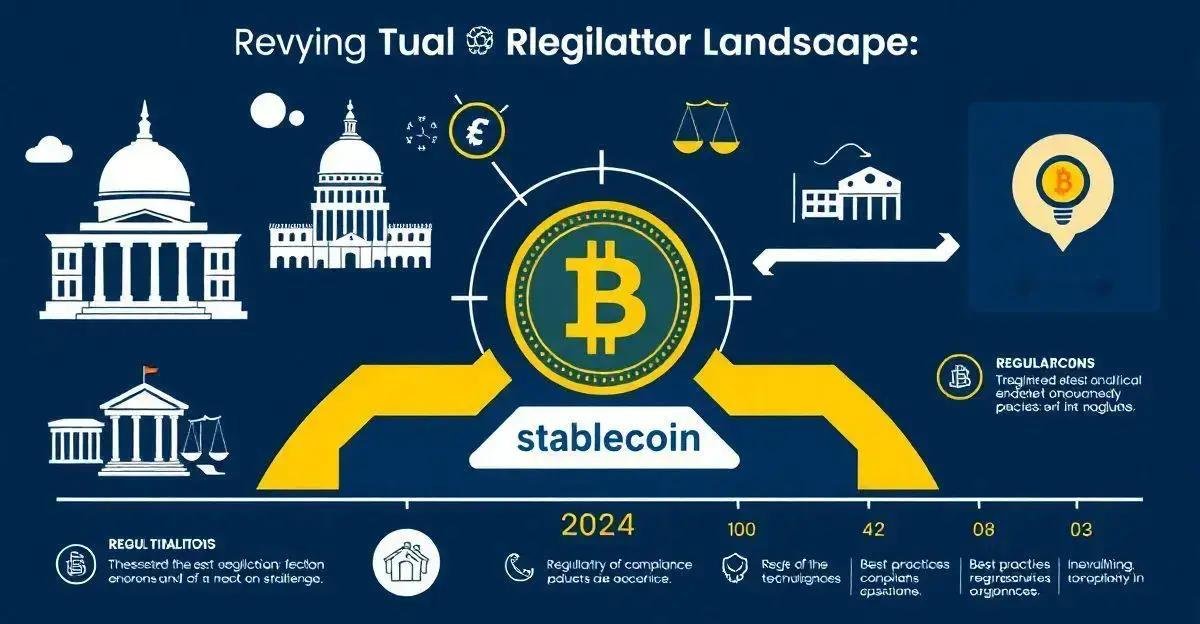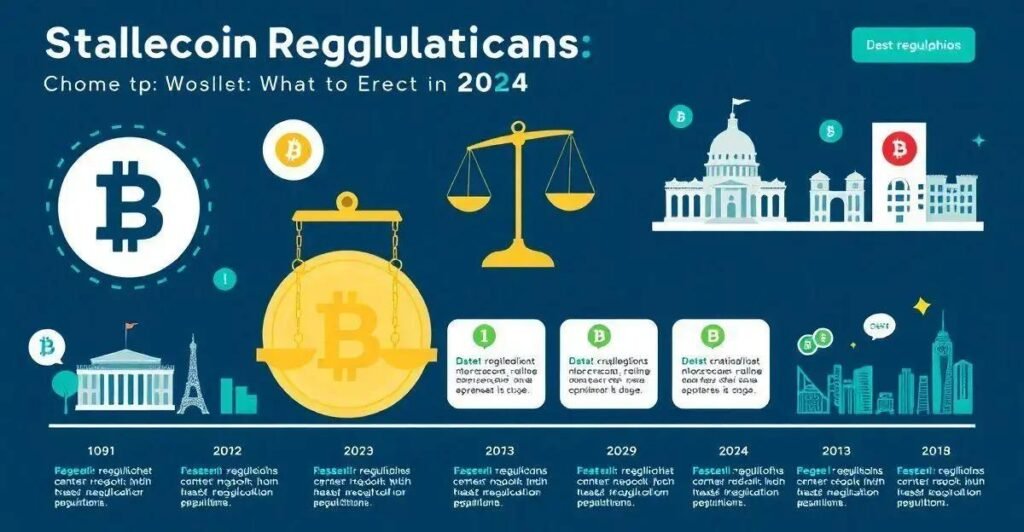Stablecoin regulation updates are reshaping the cryptocurrency landscape, offering essential insights for investors and developers.
As governments worldwide grapple with how to regulate digital currencies, understanding these changes is crucial.
This post will delve into the current regulatory landscape, identify key bodies involved, and discuss the impact of these regulations on innovation.
Stay informed and discover best practices for compliance as we explore future trends in stablecoin regulation.
Overview of Stablecoins and Their Importance
Overview of Stablecoins and Their Importance Stablecoins are a type of cryptocurrency designed to maintain a stable value by pegging them to traditional assets like the US dollar or gold. They play a vital role in the cryptocurrency market by providing a stable reserve that helps mitigate the volatility often associated with other cryptocurrencies. Investors use stablecoins to store value, facilitate trading, and participate in decentralized finance (DeFi) applications. Understanding stablecoins is crucial as they help bridge the gap between traditional finance and the growing digital economy.
Current Regulatory Landscape for Stablecoins The regulatory landscape for stablecoins is evolving rapidly as governments seek to establish guidelines that protect consumers while fostering innovation. Different countries have different approaches; some have implemented outright bans while others are working towards comprehensive regulatory frameworks. Key focus areas include anti-money laundering (AML) measures, consumer protection, and maintaining financial stability. As regulations unfold, stakeholders in the stablecoin ecosystem must stay informed about these changes to navigate compliance challenges effectively.
Key Regulatory Bodies and Their Roles Various regulatory bodies oversee stablecoin frameworks, including the Financial Stability Oversight Council (FSOC) in the United States and the European Central Bank (ECB) in Europe. These organizations assess the risks posed by stablecoins and suggest guidelines to mitigate potential threats. In addition, central banks worldwide are examining the role of stablecoins within the financial system, considering how they might impact monetary policy and financial stability.
Impact of Regulation on Innovation in Stablecoins Regulation can have both positive and negative effects on innovation in the stablecoin space. While stringent regulations may stifle creativity, they can also catalyze new opportunities for development. Compliant stablecoins may gain wider acceptance among institutional investors and users while setting a standard for security and transparency. As regulation evolves, it is crucial for developers and innovators to understand and adapt to these changes to ensure the sustainability of their projects.
Future Trends in Stablecoin Regulation The future of stablecoin regulation is likely to see increased collaboration between regulators and the private sector. As digital currencies gain traction, we may witness the establishment of global standards to address interoperability and cross-border transactions. Additionally, the rise of central bank digital currencies (CBDCs) may influence stablecoin policies, leading to new frameworks that accommodate both public and private digital currencies in a balanced manner.
Best Practices for Compliance and Adaptation For stablecoin projects, staying ahead of regulatory developments is critical. Implementing best practices, such as robust anti-money laundering procedures, regular audits, and transparent reporting, can help ensure compliance. Education and training for team members regarding legal obligations will also play a significant role. Engaging proactively with regulators can foster positive relationships and lead to smoother compliance processes.
Current Regulatory Landscape for Stablecoins

Current Regulatory Landscape for Stablecoins
The regulatory landscape for stablecoins is constantly changing as governments recognize the need to manage the risks associated with cryptocurrencies.
Different jurisdictions have adopted varied approaches, with some countries like the United States proposing legislation to enhance oversight while others are moving toward establishing clearer guidelines.
In Europe, the European Union is working on regulations that aim to create a harmonized framework across member states.
With the rise of stablecoins, regulators are particularly focused on issues such as consumer protection, anti-money laundering (AML), and ensuring financial stability.
Key considerations include how these digital assets integrate with existing financial systems and how they can be safely used by consumers.
As regulations continue to evolve, stakeholders must remain vigilant in understanding their obligations and the potential impacts on the market.
Key Regulatory Bodies and Their Roles
Key Regulatory Bodies and Their Roles
In the evolving landscape of stablecoins, various regulatory bodies play crucial roles in overseeing their use and implementation.
In the United States, the Financial Stability Oversight Council (FSOC) evaluates the risks that stablecoins pose to the economy and advises on necessary regulatory measures.
Meanwhile, the Securities and Exchange Commission (SEC) looks at whether stablecoins could be classified as securities, which would subject them to additional regulations.
Internationally, organizations like the Financial Action Task Force (FATF) set global standards to combat money laundering and ensure proper regulatory measures are in place.
The European Central Bank (ECB) also plays a significant role by assessing the stability of stablecoins within the Eurozone and determining their impact on monetary policy.
Understanding the mandates of these regulatory bodies is essential for stakeholders looking to navigate the complex landscape of cryptocurrency regulation.
Impact of Regulation on Innovation in Stablecoins

Impact of Regulation on Innovation in Stablecoins
The impact of regulation on innovation in stablecoins is multifaceted. On one hand, strict regulations can limit the ability of developers to create new and exciting products in the stablecoin space. For example, heavy compliance requirements might slow down the pace of innovation as companies spend more time and resources on meeting regulatory demands.
On the other hand, effective regulation can create a safer and more trustworthy environment for users. When consumers feel secure, they are more likely to adopt stablecoins, leading to expansion in the market. Furthermore, regulation might encourage traditional financial institutions to engage with stablecoins, providing more resources and support for innovative projects.
Therefore, while regulation may pose challenges, it can also serve as a catalyst for new ideas and growth within the stablecoin ecosystem.
Future Trends in Stablecoin Regulation
Future Trends in Stablecoin Regulation The future of stablecoin regulation is expected to evolve significantly as technology and market demand change.
One key trend is the increased collaboration between regulators and the private sector. This partnership may lead to the development of more comprehensive and flexible regulations that promote innovation while safeguarding consumers.
Additionally, we may see a shift towards global standards to enhance interoperability among different stablecoin systems.
Central bank digital currencies (CBDCs) are also likely to influence stablecoin regulations, creating new frameworks that allow for both public and private digital currencies.
As regulatory environments mature, the focus will also include consumer protection and transparency, making sure that stablecoins provide genuine value and security for users.
Best Practices for Compliance and Adaptation

Best Practices for Compliance and Adaptation To succeed in the evolving landscape of stablecoin regulations, organizations must adopt several best practices.
First, they should stay informed about the latest regulatory changes and trends affecting the stablecoin market. This requires regularly reviewing official publications from regulatory bodies and participating in industry discussions.
Second, it is essential to implement robust compliance programs that address anti-money laundering (AML) and know your customer (KYC) requirements. These programs should include regular training for employees to ensure they understand their responsibilities.
Third, companies should consider engaging with legal experts to assess their specific regulatory obligations and avoid potential pitfalls.
Additionally, transparency in operations and reporting can build trust with users and regulators alike.
Finally, fostering a culture of adaptability within the organization will allow teams to respond promptly to new regulations and market dynamics, ensuring long-term sustainability in the competitive environment of stablecoins.
Frequently Asked Questions about Stablecoins
What are stablecoins and why are they important?
Stablecoins are cryptocurrencies designed to maintain a stable value, making them important for transactions and trading.
What is the current regulatory landscape for stablecoins?
The regulatory landscape for stablecoins varies globally, with some countries proposing strict regulations while others explore guidelines.
Which bodies regulate stablecoins?
Key regulatory bodies include the Financial Stability Oversight Council (FSOC), the SEC, and the European Central Bank (ECB).
How does regulation impact innovation in stablecoins?
Regulation can both limit innovation and create a safer environment for users, leading to broader adoption of stablecoins.
What future trends can we expect in stablecoin regulation?
Future trends may include global standards for interoperability, increased collaboration between regulators and the private sector, and the influence of CBDCs.
What are best practices for compliance and adaptation in stablecoins?
Best practices include staying informed on regulations, implementing compliance programs, engaging legal experts, and fostering adaptability within the organization.



